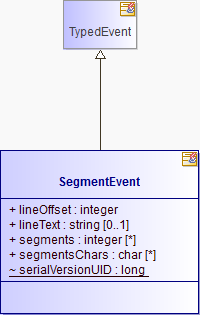- java.lang.Object
-
- java.util.EventObject
-
- org.eclipse.swt.internal.SWTEventObject
-
- org.eclipse.swt.events.TypedEvent
-
- org.eclipse.swt.events.SegmentEvent
-
- All Implemented Interfaces:
- java.io.Serializable
- Direct Known Subclasses:
- BidiSegmentEvent
public class SegmentEvent extends TypedEvent
This event is sent to SegmentListeners when a text content is to be modified. The segments field can be used in conjunction with the segmentsChars field or by itself. Setting only the segmentsChars field has no effect. When used by itself, the segments field specify text ranges that should be treated as separate segments.The elements in the segments field specify the start offset of a segment relative to the start of the text. They must follow the following rules:
- elements must be in ascending order and must not have duplicates
- elements must not exceed the text length
stored text = "R1R2R3" + "R4R5R6" R1 to R6 are right-to-left characters. The quotation marks are part of the text. The text is 13 characters long. segments = null: entire text content will be reordered and thus the two R2L segments swapped (as per the bidi algorithm). visual display (rendered on screen) = "R6R5R4" + "R3R2R1" segments = [0, 5, 8] "R1R2R3" will be reordered, followed by [blank]+[blank] and "R4R5R6". visual display = "R3R2R1" + "R6R5R4"The segments and segementsChars fields can be used together to obtain different types of bidi reordering and text display. The application can use these two fields to insert Unicode Control Characters in specific offsets in the text, the character at segmentsChars[i] is inserted at the offset specified by segments[i]. When both fields are set, the rules for the segments field are less restrictive:
- elements must be in ascending order, duplicates are allowed
- elements must not exceed the text length
- Since:
- 3.8
- See Also:
- Serialized Form
-
-
Field Summary
Fields Modifier and Type Field and Description intlineOffsetThe start offset of thelineTextrelative to text (always zero for single line widget)java.lang.StringlineTextText used to calculate the segmentsint[]segmentsText ranges that should be treated as separate segments (e.g. for bidi reordering)char[]segmentsCharsCharacters to be used in the segment boundaries (optional)(package private) static longserialVersionUID-
Fields inherited from class org.eclipse.swt.events.TypedEvent
data, display, time, widget
-
-
Constructor Summary
Constructors Constructor and Description SegmentEvent(Event e)
-
Method Summary
-
Methods inherited from class org.eclipse.swt.events.TypedEvent
getName, toString
-
-
-
-
Field Detail
-
lineOffset
public int lineOffset
The start offset of thelineTextrelative to text (always zero for single line widget)
-
lineText
public java.lang.String lineText
Text used to calculate the segments
-
segments
public int[] segments
Text ranges that should be treated as separate segments (e.g. for bidi reordering)
-
segmentsChars
public char[] segmentsChars
Characters to be used in the segment boundaries (optional)
-
serialVersionUID
static final long serialVersionUID
- See Also:
- Constant Field Values
-
-
Constructor Detail
-
SegmentEvent
public SegmentEvent(Event e)
-
-
